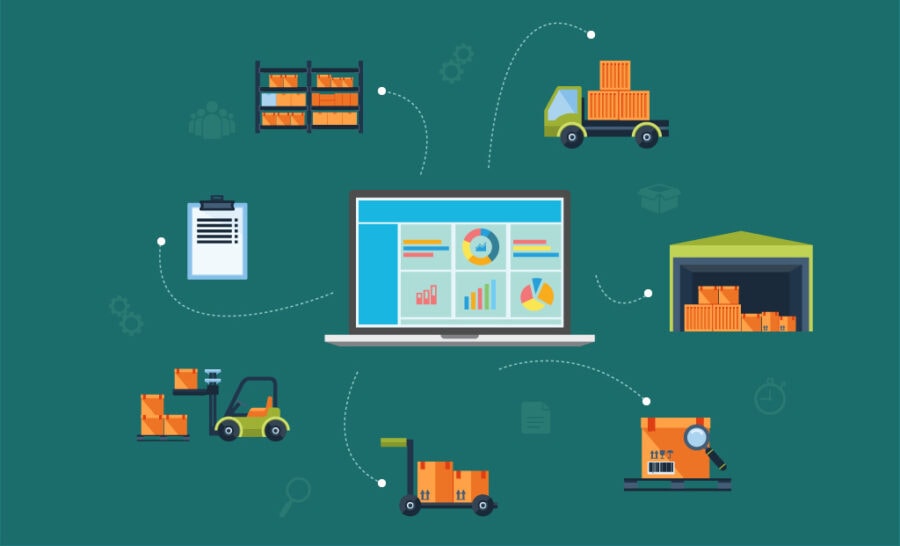In our previous blog, ‘Top Warehouse Management Challenges for Manufacturers’, we discussed top ranking warehouse management issues that impact manufacturers on a large scale. We explained how these issues prevent manufacturers from maintaining optimum inventory levels, impacts goods movement, delays production, drains bottom line and profitability. An efficient ERP software helps manufacturers to overcome these challenges.
It helps them,
- Automate warehouse management processes and workflows
- Achieve real-time visibility of warehouse operations
- Reduce paperwork and human errors
- Improve goods movement and visibility between warehouse and shop floor
- Maintain optimum inventory levels at all times
- Prevents expedited procurement orders at high costs
Let us see how an ERP software helps manufacturers achieve all these.
Comprehensive Warehouse Management
An ERP software completely automates warehouse management workflows and business processes. Manufacturers get a real-time, centralized view of warehouse operations right from the moment, procured materials arrive till it leaves for the shop floor. It streamlines goods receiving, bin-allocation, material tracking, inventory adjustment, order picking, inventory dispatch & transfer, and fulfillment. Manufacturers can easily track goods movement in and out of the warehouse and also within the warehouse using third party integration capability with bar-code and RFID technology.
This real-time view of goods procurement and movement helps manufacturers to eliminate excess stock, under-stock and obsolete stock thereby preventing cash drain.
Tight Inventory Management and Control
With an ERP software, manufacturers can always maintain consistent inventory levels at all times as they have a real-time visibility of inventory right from its procurement till it is used to manufacture the final product. Inventory planning becomes easy as manufacturers can take existing inventory levels, upcoming & existing orders into account and plan inventory procurement. This ensures that the right material is ordered at the right time for the right price from the right supplier. In case of any defect detected during or post production, manufacturers can easily trace the in-question material/product to its exact lot and recall it. This greatly minimizes recall time and associated costs. Manufacturers can also maintain a master inventory locations list that include shipping, receiving, quality hold, warehouse, work center and vendor locations.
Increase Stock Management Efficiency
An ERP software helps manufacturers to streamline their stock administration and increase its efficiency. They can track the shelf life of each material, allocate storage bins based on categories (item types) & other classification, instantly record material details on arrival and conduct inventory counting using cycle count or full inventory methods. Using integrated bar code technology, personnel can conduct inventory counting based on item types, location and warehouse.
With enhanced stock visibility and control, order picking and fulfillment becomes a breeze as warehouse personnel know the exact bin location of a particular part and they can retrieve and dispatch it quickly.
Quality Control
An ERP software’s quality management module is integrated to work with inventory management module apart from other modules. Its centralized database ensures that all non-conformance data, industry-based quality standards, and other compliance documentation are stored in a central location that is easy to access from anywhere, anytime. It is integrated into RMA, Receiving, Inventory and shop floor thereby enabling warehouse personnel to record quality and compliance data at the time of goods receiving, quality inspection and dispatch. A comprehensive quality analytics dashboard provides analytical tools that lets personnel access quality metrics for raw materials and parts.
Reduced paperwork
Warehouse management involves use of papers and spreadsheets to a great extent in a conventional setup. Everything is manually recorded and communicated with the help of papers. Spreadsheets are used to maintain a comprehensive data list. All this increases the risk of data loss, miscommunication and operational delays.
An ERP software eliminates papers and spreadsheets completely. Warehouse personnel have complete display of incoming and outgoing materials for respective jobs along with historical and future data. They have complete view of the supply chain operations that makes them more efficient and quicker.
Conclusion
An ERP software helps manufacturers tackle the most important challenge of managing materials through efficient warehouse management. Manufacturers see precious cash lying on their shelves and not materials. The faster the materials move, the quicker the cash comes in.
An ERP helps them achieve just that. It lets them go beyond ageing, legacy systems that don’t talk to each other and get a bigger picture in an instant. Wrong SKUs, expedited procurement at high costs & low quality, physical inventory counts, wrong bin allotments and increasing list of obsolete materials are a thing of the past with an ERP software.




